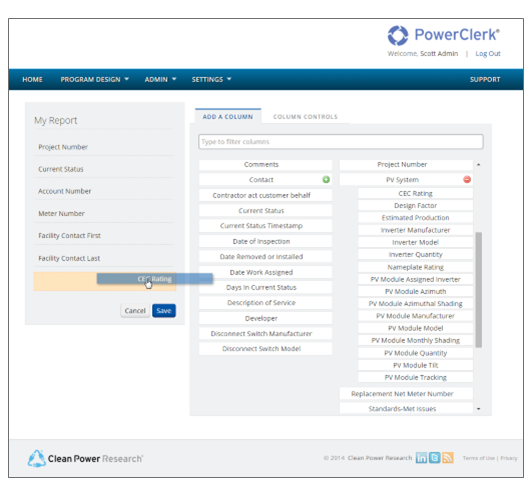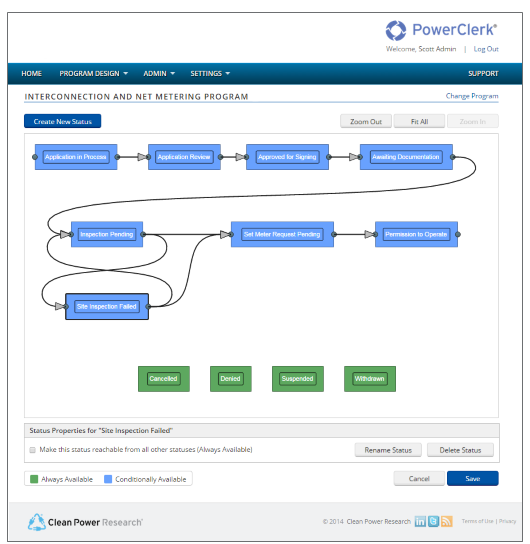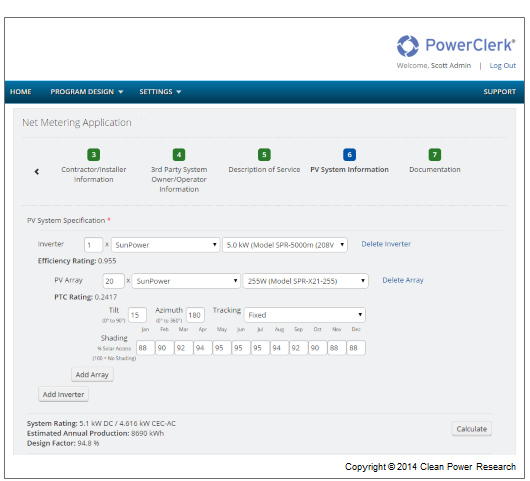
We’re very excited to be releasing the latest product in our PowerClerk® family of products—PowerClerk® Interconnect—this week. Developed and launched with the help of a Department of Energy Sunshot Incubator award, PowerClerk Interconnect is already helping NV Energy streamline its solar interconnection program.
If you’re considering improvements to your distributed generation interconnection processes, or just want to learn more, here are answers to five of the most frequently asked questions about PowerClerk Interconnect:
- What problems are utilities trying to solve?
At the highest level, utilities are working to meet the needs of increasingly sophisticated customers who face an ever-broadening range of options for their energy needs. When it comes to interconnection specifically, utilities are managing increasing numbers of applications for distributed solar interconnection to their grids. Although it may seem straightforward, interconnection processes are important to ensuring the safe, reliable power that utilities provide remains so (even as some power is generated locally; e.g., on a homeowner’s roof).As solar becomes more popular, utilities are faced with the challenge of efficiently managing increasing volumes of applications, and keeping the many constituents on any one application—the homeowner, contractor, inspector, etc.—informed about requirements and status.Beyond managing the interconnection process, utilities also need to capture intelligence about their distributed solar fleets. When combined with other tools—such as WattPlan™ and SolarAnywhere® FleetView® from Clean Power Research, or software from other vendors—it’s possible to understand the impact of distributed generation on circuits and utility infrastructure.By taking interconnection online, PowerClerk makes it possible for utilities to efficiently process applications—from a couple hundred to thousands of applications per year—while improving customer service and reducing costs for both utilities and installers. In addition, utilities will systematically capture solar fleet data in a format that enables integration with other software tools for long-term planning and operations. - What’s the big deal about interconnection?
One goal of the Department of Energy’s SunShot Initiative is to reduce solar ‘soft costs’—which today make up a large portion of the cost of a distributed solar system—and interconnection is one of those soft costs. Like any process, there are efficient and inefficient ways of managing it, and today, approximately 85% of utilities are using paper-based application processes, which by nature are inefficient. Inefficiency leads to higher costs—both for utilities and the solar industry.A recent SEPA report on interconnection found that some of the most common challenges for utilities are:- Ensuring application accuracy and completeness
- Communicating with customers
- Obtaining signatures
- Reporting statistics
- Filing paperwork
- Tracking application status
- Scheduling
By taking formerly paper-intensive interconnection processes online, PowerClerk meets all of these challenges head-on.

PowerClerk Interconnect makes custom reporting of solar fleets simple
- Aren’t utilities already processing applications online?
According to SEPA’s recent research, today only about 15% of utilities process applications online—the most common approach is still ‘paper’ forms. Many of the current online solutions are simply PDF forms available online. Some make it possible to fill-out and submit electronically, usually by email.The end-to-end automation that PowerClerk has provided for incentives and now interconnection is not seen in other approaches. It’s a comprehensive approach that automates and digitizes communications, document/contract generation, electronic signatures and more.When we say end-to-end, we mean it: PowerClerk Interconnect exposes automation to contractors and installers for application submission, while also enabling utility IT system integration with backend enterprise resource planning (ERP), customer information, billing and other software. - Utilities have been using PowerClerk Incentives for incentive application management for a long time—what’s different about PowerClerk Interconnect?
With PowerClerk Interconnect, we’ve built-in the best features of PowerClerk Incentives—transparent processes, automated communications and comprehensive access to distributed fleet data—on a new platform that gives program administrators unprecedented control over their program design and additional flexibility.In the past, when administrators needed a change made to their program—say a new inspection was required—the utility would contact Clean Power Research, and we would implement the configuration changes through software code changes. This might mean the utility would wait a few days or weeks before their program change was implemented depending on the condition of the engineering queue.
Drag-and-drop design surfaces enable interconnection administrators to
quickly create and modify interconnection workflowsWith PowerClerk Interconnect, program administrators will be equipped to make those changes themselves, from within the tool, right from their browser. This gives them maximum control over their programs—a capability that is very important to program administrators.
- Is PowerClerk Interconnect hard to use?
One of our customers recently said that using PowerClerk is like using TurboTax®—it walks you through each step of the process, which consists of a series of forms that are straightforward to fill out. The elegance and intuitiveness that enable that to be true are especially critical for applicants, who are typically solar installers and contractors. We often hear from installers that during busy times, they hire interns to come in and fill out applications, and that they’re able to get those interns up and running with almost no training.We also take utility administrator usability seriously. Usually it only requires a single one- to two-hour training session to get utility program administrators up-to-speed and ready to use PowerClerk for the fundamentals of application processing (i.e., status updating), custom communications and reporting. Often, new PowerClerk customers end up canceling requested onsite training sessions from Clean Power Research (saving time and money) once they realized that in spite of the deep level of automation it provides, PowerClerk doesn’t require extensive training.
Forms are arranged in easy, step-by-step sequence
If you’d like to learn more about PowerClerk Interconnect, here’s a list of resources (or Contact Us):
